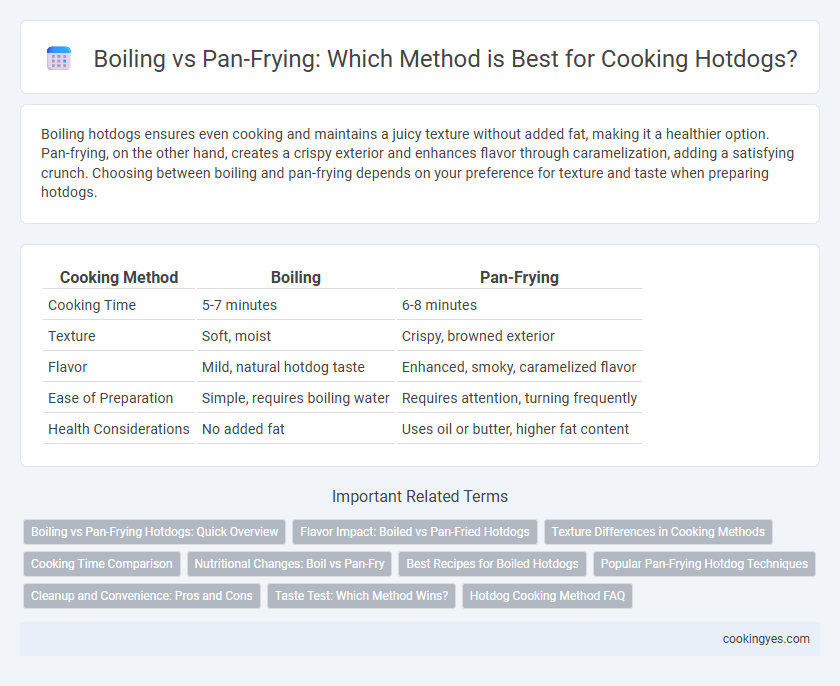Boiling hotdogs ensures even cooking and maintains a juicy texture without added fat, making it a healthier option. Pan-frying, on the other hand, creates a crispy exterior and enhances flavor through caramelization, adding a satisfying crunch. Choosing between boiling and pan-frying depends on your preference for texture and taste when preparing hotdogs.
Table of Comparison
| Cooking Method | Boiling | Pan-Frying |
|---|---|---|
| Cooking Time | 5-7 minutes | 6-8 minutes |
| Texture | Soft, moist | Crispy, browned exterior |
| Flavor | Mild, natural hotdog taste | Enhanced, smoky, caramelized flavor |
| Ease of Preparation | Simple, requires boiling water | Requires attention, turning frequently |
| Health Considerations | No added fat | Uses oil or butter, higher fat content |
Boiling vs Pan-Frying Hotdogs: Quick Overview
Boiling hotdogs ensures even cooking and preserves moisture, resulting in a juicy texture, while pan-frying enhances flavor through caramelization and creates a crispy exterior. Boiled hotdogs typically cook faster and require less attention, making them ideal for quick preparation. Pan-frying allows for added seasoning and a more robust taste, appealing to those seeking a savory and slightly charred bite.
Flavor Impact: Boiled vs Pan-Fried Hotdogs
Boiling hotdogs results in a juicy and tender texture, preserving the sausage's natural flavor without additional browning or crispiness. Pan-frying, on the other hand, enhances flavor through caramelization and Maillard reaction, creating a crispy exterior with a richer, more complex taste. The choice between boiling and pan-frying significantly influences the flavor profile, with pan-fried hotdogs offering a more robust savory experience compared to the milder, more straightforward taste of boiled hotdogs.
Texture Differences in Cooking Methods
Boiling hotdogs results in a softer, juicier texture as the sausages absorb water and heat evenly, preserving moisture inside. Pan-frying creates a crispier exterior by rendering the fat and caramelizing the surface, enhancing flavor and adding a slight crunch. Choosing between boiling and pan-frying impacts whether the hotdog delivers a tender bite or a satisfyingly crisp snap.
Cooking Time Comparison
Boiling hotdogs typically takes around 5 to 7 minutes, resulting in evenly heated sausages with a moist texture. Pan-frying requires approximately 6 to 8 minutes, offering a slightly crispier exterior and enhanced flavor through caramelization. Choice of cooking method depends on desired texture and preparation speed, with boiling being quicker and pan-frying adding a richer taste.
Nutritional Changes: Boil vs Pan-Fry
Boiling hotdogs preserves more moisture and results in lower fat content compared to pan-frying, which causes fat to render out, increasing calorie density. Pan-frying can enhance flavor through Maillard reactions but may raise levels of advanced glycation end products (AGEs), potentially impacting health. Nutritionally, boiling retains more vitamins and minerals, while pan-frying tends to reduce these nutrients due to higher heat exposure.
Best Recipes for Boiled Hotdogs
Boiling hotdogs preserves their juicy texture and enhances the classic flavor, making it a popular method for authentic recipes like New York-style hotdogs served with sauerkraut and mustard. For best results, simmer hotdogs in water just below boiling temperature for 5-7 minutes to avoid splitting and ensure even heating. Pair boiled hotdogs with soft buns and traditional condiments such as yellow mustard, diced onions, and relish for a balanced taste experience.
Popular Pan-Frying Hotdog Techniques
Pan-frying hotdogs enhances flavor and texture by creating a crispy exterior and caramelized edges, often achieved by cooking in a hot skillet with a small amount of oil or butter. Popular techniques include scoring the hotdogs to prevent curling and increase surface area for browning, and cooking on medium-high heat for 3-5 minutes per side to ensure even crispiness without burning. This method retains juiciness while delivering a satisfying crunch that boiling lacks, making it a preferred choice for flavorful hotdog preparation.
Cleanup and Convenience: Pros and Cons
Boiling hotdogs offers a quick cleanup since it involves only a pot of water, minimizing greasy residue and making it convenient for messy-free preparation. Pan-frying creates a flavorful, crispy exterior but often leads to oil splatters that require thorough stove and pan cleaning, adding to post-cooking effort. Choosing between boiling and pan-frying depends on prioritizing ease of cleanup or taste enhancement in hotdog preparation.
Taste Test: Which Method Wins?
Boiling hotdogs preserves juiciness and delivers a classic, mild flavor, while pan-frying creates a crispy exterior with intensified smoky, caramelized notes. Taste tests often favor pan-fried hotdogs for their enhanced texture and richer taste, appealing to those who enjoy a savory, slightly crisp bite. Boiling remains popular for a softer, traditional experience, ideal for pairing with softer buns and lighter condiments.
Hotdog Cooking Method FAQ
Boiling hotdogs preserves juiciness and delivers a tender texture, often preferred for its simplicity and even heating. Pan-frying enhances flavor by creating a crispy exterior and caramelized edges through direct contact with the hot surface. Choosing between boiling and pan-frying depends on whether you prioritize moisture retention or a crispy, flavorful bite.
Boiling vs pan-frying for hotdog cooking Infographic

 cookingyes.com
cookingyes.com